What Time to Feed Your Puppy: A Confident and Knowledgeable Guide
Two of the most common questions I get asked by new dog parents are when to feed a puppy and how much food to give them. In this article, we will go through these questions and more.

It’s essential to feed your puppy properly for their health and growth. This guide explains the feeding schedule, including moving from bottle to solid foods, adjusting meal frequency as your puppy matures, and choosing the right food.
What Time to Feed Your Puppy?
For a three-meal schedule, feed your puppy in the morning (around 7 a.m.), midday (around 12 p.m.), and evening (around 5 p.m.). For very young puppies (8-12 weeks old), a four-meal schedule might be better, with meals in the early morning (around 7 a.m.), mid-morning (around 11 a.m.), afternoon (around 2 p.m.), and evening (around 6 p.m.).
Consider your puppy’s breed when deciding on food type, quantity, and feeding times—research specific needs for breeds like Goldendoodles.
We offer advice on switching to adult food in this article. For detailed guidance, refer to our comprehensive guide on this topic.
What Time to Feed Your Puppy
Three-Meal Schedule for Puppies
Adopt a three-meal schedule until six months old:
- Morning: Start with a meal at 7 a.m. for energy.
- Midday: Feed at 12 p.m. to maintain energy.
- Evening: Last meal at 5 p.m. for overnight sustenance.
Remember, these times are just a guideline and can be adjusted to fit your schedule. The key is consistency, as puppies thrive on routine. Also, ensure that the meals are evenly spaced out and that you’re feeding your puppy a balanced diet suitable for their age, breed, and size.
Daily Schedule Example:
| Time | Activity |
|---|---|
| 6:30 a.m. | Wake up, take longer walk and potty break |
| 7:00 a.m. | Serve breakfast, the first designated meal |
| 9:30 a.m. | Mid-morning obedience training and active training, plus potty break |
| 12:30 p.m. | Serve lunch, the second designated meal |
| 3:30 p.m. | Mid-afternoon playtime, training, and potty break |
| 6:30 p.m. | Serve dinner, the third designated meal |
| 9:30 p.m. | Potty break and bedtime training session, could be a calm activity like “find the toy” |
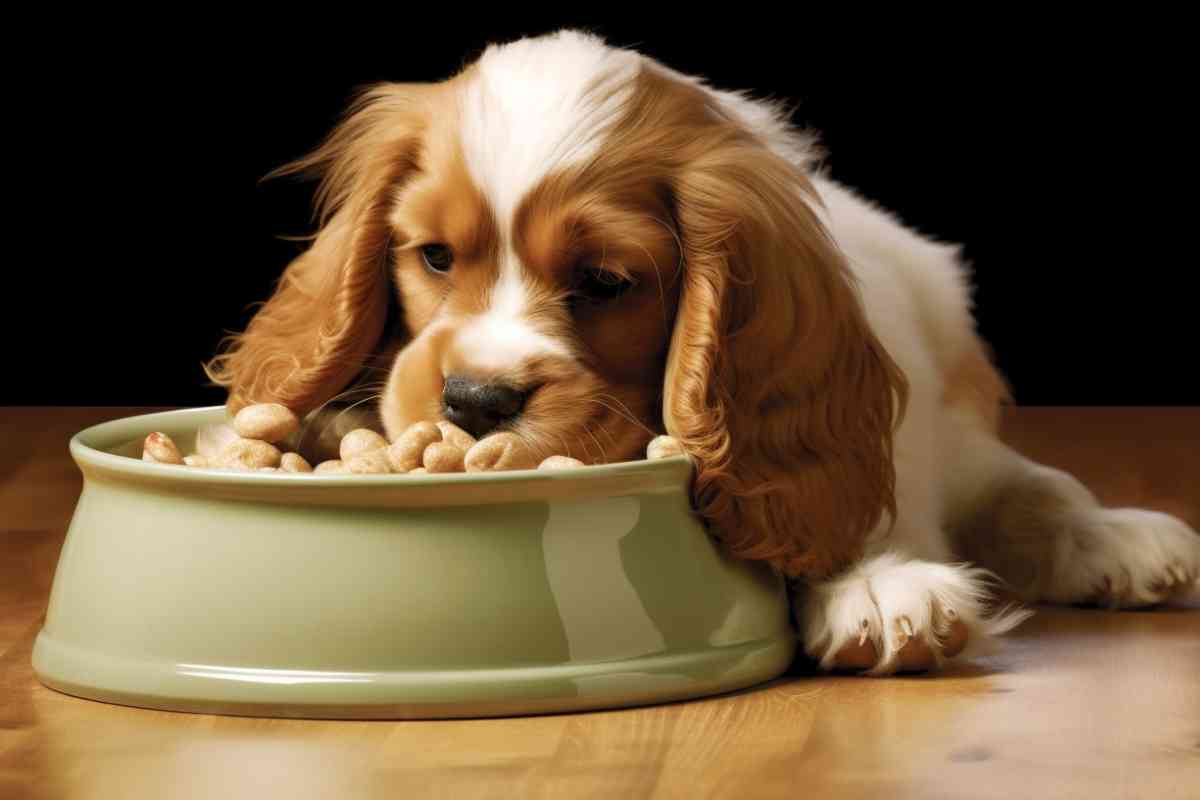
Four-Meal Schedule for Puppies
Similar to three-meal, but includes a fourth meal to meet their high nutritional needs.
Feeding and Training Tips:
- Use Regular Food as Rewards: Dedicate 20-30% of daily food for behavior reinforcement.
- Maintain Regular Meal Times: Adjust portion sizes accordingly.
- Monitor Intake: Ensure they’re not overfed with rewards.
- Avoid Late Feeding: Finish feeding three hours before bedtime to aid house training.
Again, these times are just a guideline and can be adjusted to fit your schedule. The key is consistency. Also, ensure that the meals are evenly spaced out and that you’re feeding your puppy a balanced diet suitable for their age, breed, and size.
Daily Schedule Example:
| Time | Activity |
|---|---|
| 6:30 a.m. | Wake up, longer walk and potty break |
| 7:00 a.m. | Serve breakfast, the first designated meal |
| 9:30 a.m. | Mid-morning obedience training and potty break |
| 11:30 a.m. | Serve lunch, the second designated meal |
| 1:30 p.m. | Mid-afternoon playtime, training, and potty break |
| 4:30 p.m. | Serve the third designated meal |
| 7:30 p.m. | Bedtime training session, could be a calm activity like “find the toy” |
| 9:30 p.m. | Serve a bedtime snack, the fourth designated meal |
| After 9:30 p.m. | Last potty break |
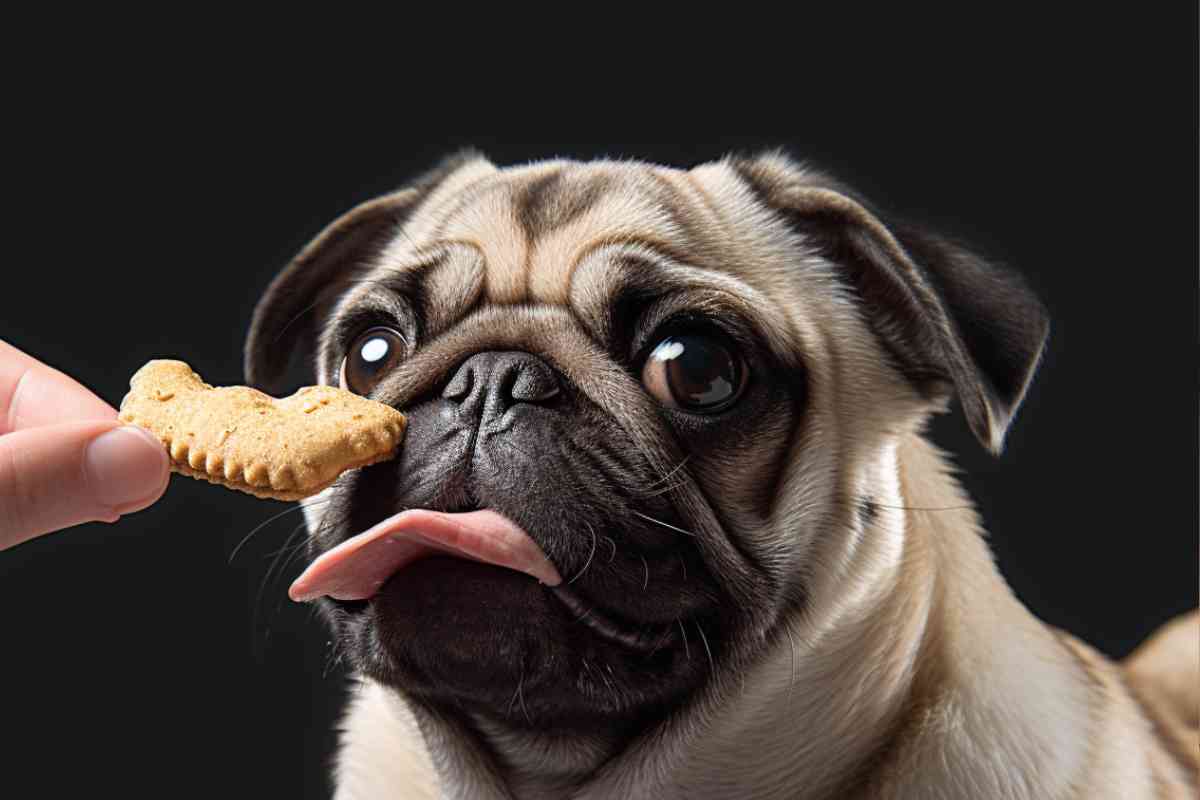
Using Regular Food as Rewards: A Guide for Puppy Feeding
Feeding your puppy doesn’t have to be confined to meal times. In fact, using their regular food as rewards throughout the day can be an effective way to reinforce good behavior and aid in training, all while ensuring they receive their necessary nutrition.
Here’s how to do it:
- Set Aside a Portion: At the start of the day, set aside a portion of your puppy’s daily food allowance to use as rewards. This could be around 20-30% of their daily kibble.
- Reward Good Behavior: Throughout the day, use the kibble as rewards for good behavior. This could be when your puppy sits on command, comes when called, or during potty training.
- Maintain Meal Times: Continue to feed your puppy their regular meals at the usual times, but reduce the portion size to account for the food you’re using as rewards.
- Monitor Your Puppy’s Intake: Keep track of how much food your puppy is consuming as rewards. If you notice that they’re not hungry at meal times, you may need to reduce the amount of food you’re using as rewards.
- Consider Bedtime: Be mindful of your puppy’s bedtime. Aim to finish all feeding, including rewards, at least three hours before bedtime. This allows your puppy enough time to digest their food and eliminate, which aids in house training.
Remember, consistency is key. Regular feeding and reward times can help establish a routine, making training easier and more effective.
Bottle Feeding Schedule for Puppies
Bottle Feeding Schedule:
- Newborn to One Week: Every 2-3 hours.
- One to Two Weeks: Every 3-4 hours.
- Three to Four Weeks: Every 4-6 hours.
Consult a vet for tailored schedules, especially for breeds prone to bloat. Use a puppy milk replacer and never cow’s milk.
Remember, these are general guidelines and the exact feeding schedule can vary depending on the puppy’s size, breed, and overall health. Always consult with a vet to determine the best feeding schedule for your puppy.
Also, it’s important to ensure the puppy is warm before feeding, as cold puppies can’t digest food properly. Never feed a puppy cow’s milk, as it can cause digestive issues. Use a puppy milk replacer, which is specially formulated to meet the nutritional needs of growing puppies.
Bottle feeding puppies can be a challenging task, but it’s also a rewarding one. With proper care and nutrition, your puppy will grow into a healthy and happy dog.
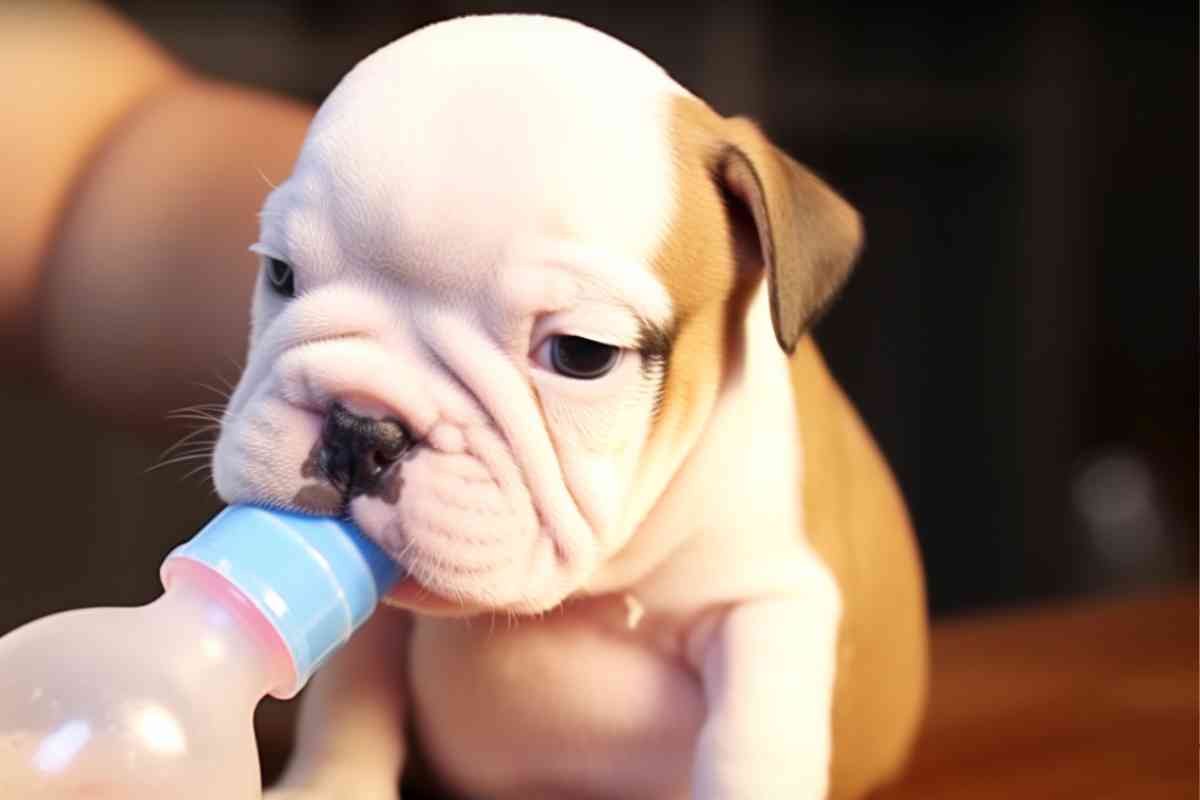
Transitioning a Puppy from Bottle to Solid Food
The transition from bottle feeding to solid food is a significant milestone in a puppy’s life. This process, known as weaning, typically begins when puppies are about 3-4 weeks old and continues until they’re 7-8 weeks old. Here’s a step-by-step guide on how to do it:
- Introduce a Gruel Mixture: Start by introducing a gruel mixture. This is made by blending a high-quality puppy food with puppy milk replacer to create a thin, soupy mixture.
- Encourage Exploration: Let the puppies explore the gruel. They might walk in it, play in it, or even start to lap it up. This messy exploration is a normal part of the process.
- Gradually Thicken the Gruel: Over the next few weeks, gradually thicken the gruel by adding less liquid. This helps the puppies adjust to the texture of solid food.
- Introduce Dry Kibble: Once the puppies are happily eating the thickened gruel, start introducing dry kibble. You can do this by mixing some into the gruel.
- Gradually Reduce Bottle Feedings: As the puppies eat more of the gruel and kibble, start to reduce the number of bottle feedings. By around 7-8 weeks old, the puppies should be eating solid food completely.
- Monitor Each Puppy: Keep an eye on each puppy to ensure they’re eating enough and not experiencing any digestive issues. If a puppy seems to be struggling with the transition, consult with a vet.
Remember, this is a gradual process and each puppy may progress at their own pace. Patience and consistency are key to a successful transition from bottle to solid food.
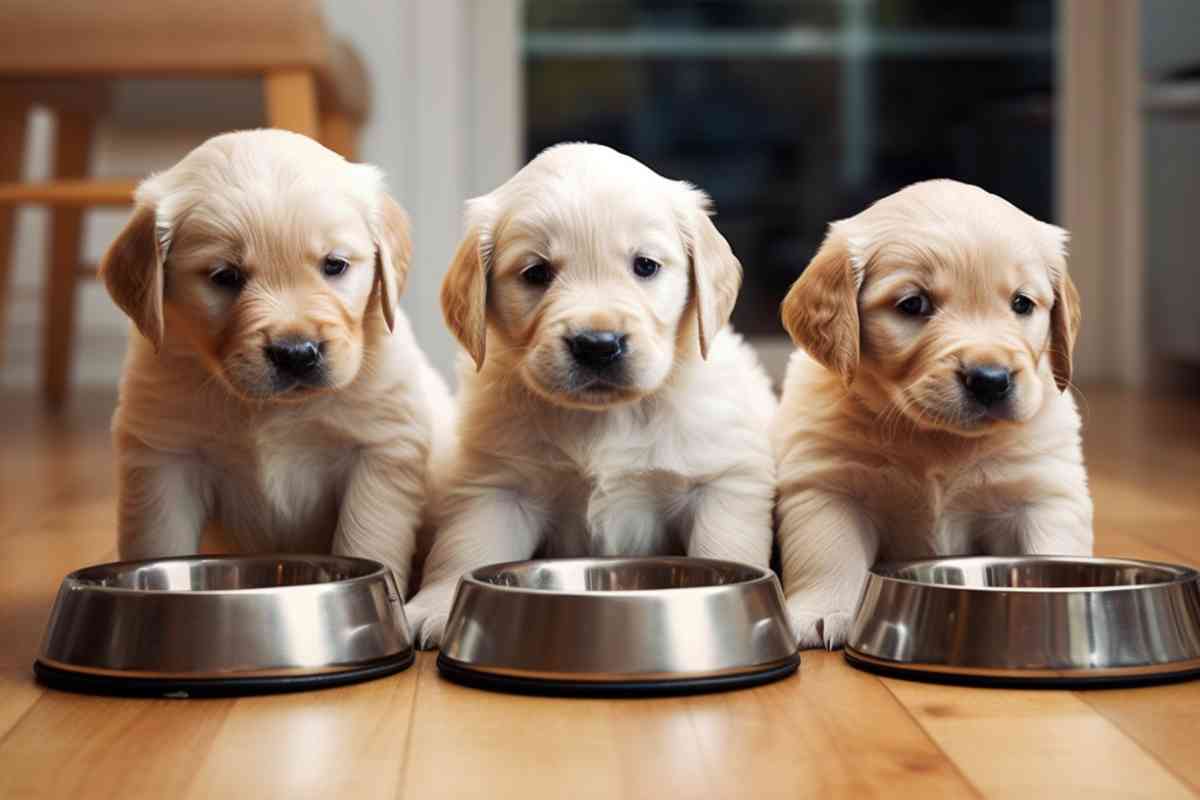
Feeding Multiple Puppies: A Guide
Feeding multiple puppies can be a bit of a challenge, but with the right approach, you can ensure all your puppies get the nutrition they need. Here are some tips:
- Individual Bowls: Each puppy should have their own food bowl. This helps prevent competition over food and ensures each puppy gets the right amount of food.
- Separate Feeding Areas: If possible, feed your puppies in separate areas. This can help reduce distractions and prevent food aggression.
- Monitor Eating Habits: Keep an eye on each puppy’s eating habits. Some puppies may eat faster than others, which could lead to overeating if they start to eat another puppy’s food. If this happens, you may need to separate the puppies during meal times.
- Consistent Portions: Make sure each puppy gets the right portion size based on their age, size, and breed. Don’t let a larger or more dominant puppy eat another puppy’s food.
- Regular Feeding Times: Stick to a regular feeding schedule. Puppies thrive on routine, and regular feeding times can help with house training.
- Consult a Vet: If you’re unsure about how much to feed each puppy, or if one puppy seems to be eating less or more than their siblings, consult with a vet. They can provide personalized advice based on each puppy’s specific needs.
Remember, feeding time should be a calm and positive experience for your puppies. With patience and consistency, you can establish a feeding routine that works for all your puppies.
Treats for Puppies: How Many Are Okay?
Treat Guidelines:
- Limit Treats: No more than 10% of daily intake.
- Choose Quality: Opt for high-quality, size-appropriate treats.
- Use Kibble as Treats: Helps maintain a balanced diet.
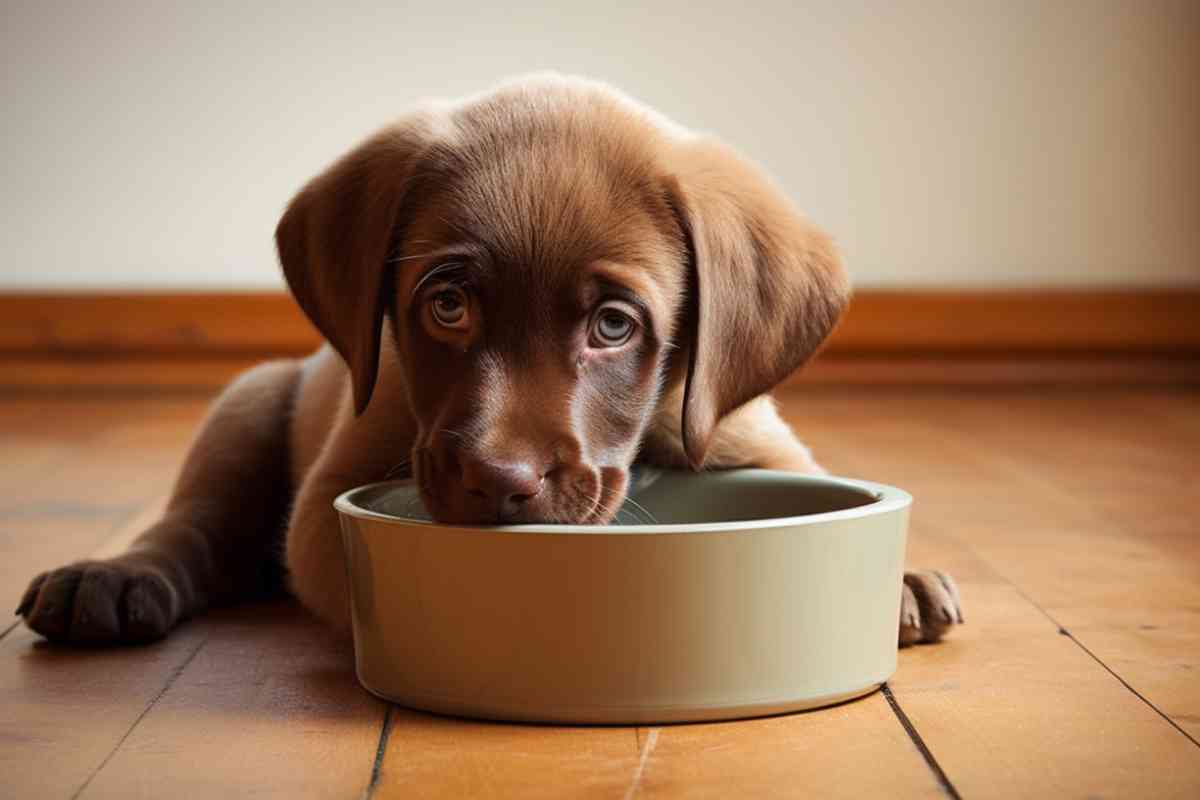
Feeding Puppies to Prevent Bloat
Bloat, or Gastric Dilatation-Volvulus (GDV), is a serious condition that can affect dogs, particularly large breeds and deep-chested dogs. It involves the stomach filling with gas and possibly twisting, which can be life-threatening.
Vets are concerned about just how common bloat is. The AKC is also working actively to avoid this condition through responsible breeding. However, at this time, it’s still possible for your puppy to get bloat, especially if they are on of the breeds the condition is common in. Based on the research, here’s how to feed puppies to help prevent this condition:
Preventing Bloat:
- Smaller, Frequent Meals: Reduces stomach filling speed.
- Slow Eating: Prevents air swallowing.
- Limit Post-Meal Activity: Reduces bloat risk.
- Avoid Elevated Bowls: May increase bloat risk.
Breeds prone to bloat include large breeds like Great Danes, Saint Bernards, and Weimaraners, as well as deep-chested breeds like Boxers and Basset Hounds. However, any dog can potentially suffer from bloat.
Remember, while these tips can help reduce the risk of bloat, they can’t eliminate it completely. Always monitor your puppy for signs of bloat, such as a swollen abdomen, restlessness, drooling, or attempts to vomit without producing anything. If you suspect bloat, seek veterinary attention immediately.
What time should I feed my puppy at night?
Night Feeding: Serve the last meal three hours before bedtime, adjusting based on your puppy’s needs.
The last meal should be served about three hours before your puppy’s bedtime, allowing ample time for digestion and elimination before they settle down for the night. However, every puppy is unique.
Some might need a small snack before bed, while others do better with an earlier dinner. Always pay attention to your puppy’s signals and adjust the schedule as needed.
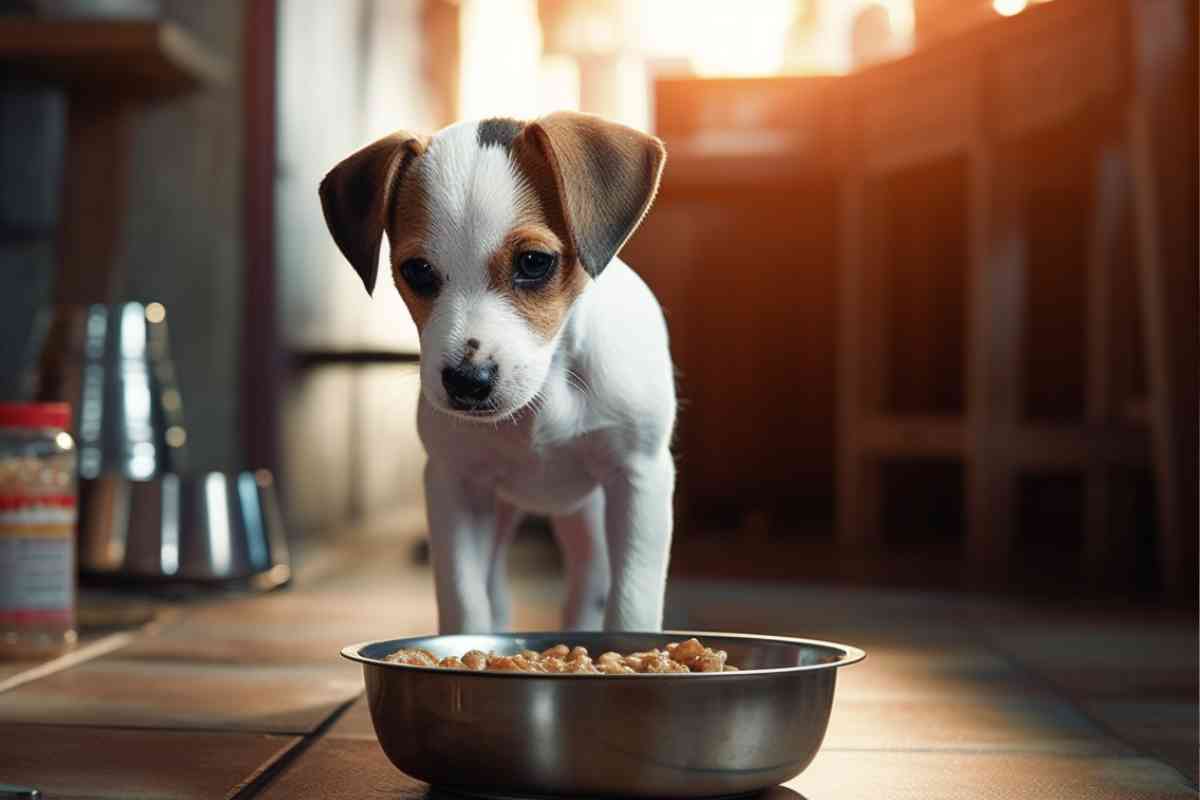
Meal Frequency Adjustment:
- Three meals up to Six Months: Then transition to two meals.
- Switching to Two Meals: Depends on breed, growth rate, and health.
Gradually adjust feeding schedules for smooth transitions. Consult a vet for personalized advice.
How long do puppies need 3 meals a day?
Puppies grow rapidly and require more frequent meals compared to adult dogs. Typically, a three-meal feeding schedule is recommended for puppies until they are around six months old. During this period, their nutritional needs are high, and smaller, more frequent meals help ensure they get the nutrients they need for healthy growth.
However, it’s important to remember that every puppy is unique. The transition from three meals to two meals a day can depend on factors like breed size, individual growth rate, and overall health. Larger breeds may require three meals a day for longer than smaller breeds.
When to switch puppy to 2 meals a day
As your puppy grows and matures, their feeding schedule will need to change. But when is the right time to switch from three meals a day to two? Let’s explore.
Typically, the transition to two meals a day occurs when your puppy is around six months old. However, this can vary based on breed and size. Larger breeds may benefit from staying on a three-meal schedule for a bit longer, while smaller breeds might be ready to switch a little earlier.
Here are a few signs that your puppy might be ready to transition to two meals a day:
- Decreased Appetite: If your puppy starts leaving food in their bowl or shows less interest in their midday meal, it might be time to switch to two meals a day.
- Stable Weight and Growth: Once your puppy’s growth starts to slow down and their weight stabilizes, they might not need that extra meal anymore.
- Maturity: As your puppy matures, they’ll be able to handle larger portions and longer periods between meals.
Remember, any changes to your puppy’s feeding schedule should be made gradually to avoid upsetting their stomach. Start by slowly increasing the size of the morning and evening meals while decreasing the size of the midday meal.
Transitioning to a One-Meal-a-Day Feeding Schedule
As your puppy grows into adulthood, you might consider transitioning them to a one-meal-a-day feeding schedule. Typically, this transition occurs when your dog is about a year old, but the exact timing can vary based on breed and size.
There are several reasons why feeding your dog once a day might be beneficial. Some studies suggest that dogs fed once a day may have better health outcomes, including improved metabolic health and weight management. Feeding once a day can also be more convenient for many dog owners, aligning with their daily routines.
However, it’s important to note that a one-meal-a-day schedule isn’t suitable for all dogs. Dogs prone to bloat, a serious condition that can affect large breeds and deep-chested dogs, should stick to multiple small meals throughout the day. Feeding smaller, more frequent meals can help prevent their stomach from becoming too full too quickly, which can contribute to bloat.
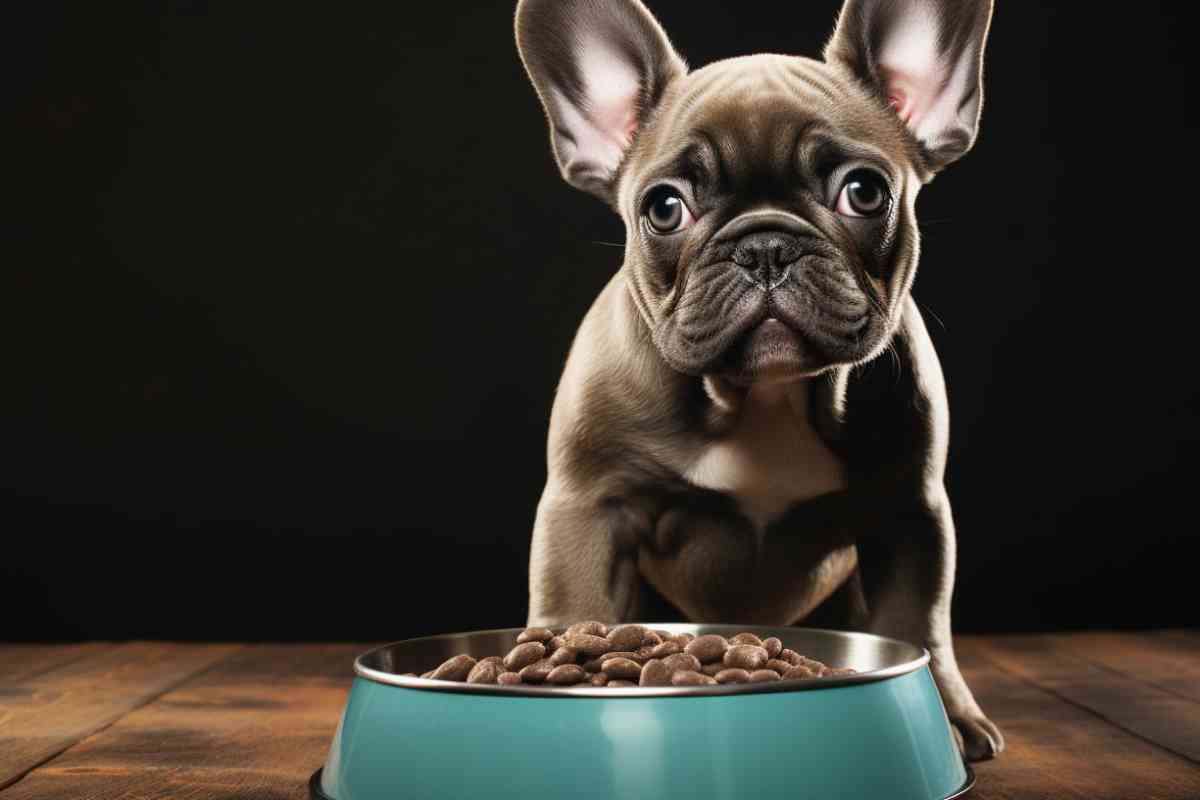
How Much to Feed Your Puppy
Feeding your puppy the right amount of food is crucial for their growth and development. The amount of food your puppy needs depends on several factors, including their age, weight, breed, and overall health. Here’s a comprehensive guide based on the American Kennel Club and Purina.
- Age: Puppies are busy growing and need more calories, along with higher levels of protein and other nutrients, than older dogs. As they age, their calorie needs may drop, and they may begin leaving some food in the bowl. This isn’t an indication of dislike for the food. Instead, begin offering less so your puppy doesn’t overeat and stays in ideal body condition.
- Weight: The amount of food your puppy needs depends on how much they’ll weigh at maturity. A Labrador Retriever will weigh more at maturity than a Russell Terrier, for example. So, the larger dog requires more food as a puppy.
- Body Condition: The best way to decide if your dog is getting the right amount of food is to look at them. If your dog has a visible waist, they’re well proportioned, and you can feel their ribs, they’re probably getting the right amount of food. If your puppy becomes overweight, a reduction of your puppy’s daily food intake may be appropriate.
- Breed Size: Not only do puppies need puppy food, but certain breed sizes can benefit from size-specific formulas. If you have a large breed puppy, they may benefit from a large breed-specific puppy formula. Small breeds may prefer smaller kibble so they can more easily chew their food, which helps ensure they get all the nutrients they need.
- Activity Level: Different dogs need different amounts of calories, depending on activity level, age, and even environmental conditions. Active dogs use more energy and require more calories than some sedentary breeds.
Purina provides a helpful puppy feeding chart that can serve as a starting point to help you determine how much dry kibble to feed your puppy. However, these are generic recommendations only. Always consult with your vet to develop a feeding plan specifically for your puppy’s needs.
Remember, maintaining ideal body condition is key to encouraging proper growth in all puppies, especially large breeds. As puppies near adulthood, their calorie needs may drop, and your puppy may begin leaving some food in the bowl. Don’t misinterpret this as an indication of dislike for the food. Instead, begin offering less so your puppy doesn’t overeat and stays in ideal body condition.
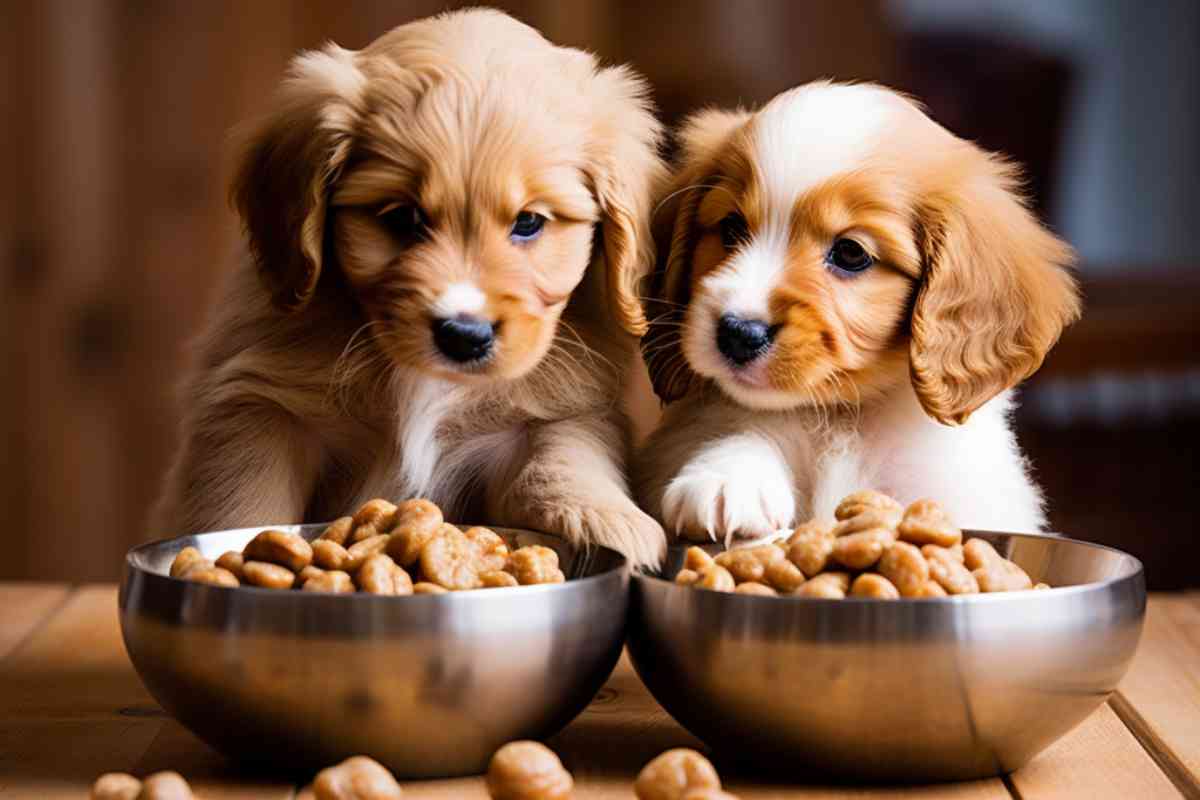
How much to feed a puppy by weight (kg)
Feeding your puppy the right amount of food is crucial for their growth and development. However, determining the exact amount can be tricky as it depends on various factors such as the puppy’s age, breed, eventual size, activity level, and overall health. Here’s a general guideline based on weight:
- Puppies weighing 1 kg: Approximately 50 grams of dry food per day.
- Puppies weighing 5 kg: Approximately 200 grams of dry food per day.
- Puppies weighing 10 kg: Approximately 300 grams of dry food per day.
- Puppies weighing 20 kg: Approximately 500 grams of dry food per day.
These are rough estimates and the actual amount can vary. Puppies usually need a diet rich in protein and fat. High-quality puppy food will have feeding guidelines on the packaging, which can be a helpful starting point.
Remember, puppies grow fast and their dietary needs change quickly. It’s important to regularly monitor your puppy’s weight and adjust their food intake accordingly. Overfeeding can lead to obesity and other health issues, while underfeeding can hinder their growth.
Why Not Free Feed a Puppy?
Ever wondered if it’s okay to leave a bowl full of food out for your puppy all day? It’s a common question, and you’re not alone. But is it the best approach? Let’s dive into the reasons why free feeding might not be the best choice for your puppy.
Overeating and Obesity
Firstly, puppies don’t always know when to stop eating. Given unrestricted access to food, they’re likely to eat more than they need. This overeating can quickly lead to obesity, a serious health issue. According to the Association for Pet Obesity Prevention, over 56% of dogs in the U.S. are overweight or obese. Obesity in dogs can lead to numerous health problems, including diabetes, heart disease, and joint problems.
Difficulty in House Training
Free feeding can also make house training more challenging. If your puppy eats whenever they want, they’ll also need to go to the bathroom at unpredictable times. Having a set feeding schedule helps you predict when your puppy will need to go outside, making house training easier.
Food Freshness and Attracting Pests
Leaving food out all day can also lead to it becoming stale or spoiled, which isn’t good for your puppy’s health. Additionally, it could attract pests like ants or rodents into your home.
Inability to Monitor Food Intake
Lastly, free feeding makes it hard to monitor how much your puppy is eating. Changes in appetite can be an early sign of illness in dogs. If you’re free feeding, you might not notice if your puppy starts eating less than usual.
So, what’s the alternative? Scheduled feeding! It helps control portion sizes, aids in house training, and allows you to monitor your puppy’s food intake. It’s a win-win situation for both you and your furry friend!
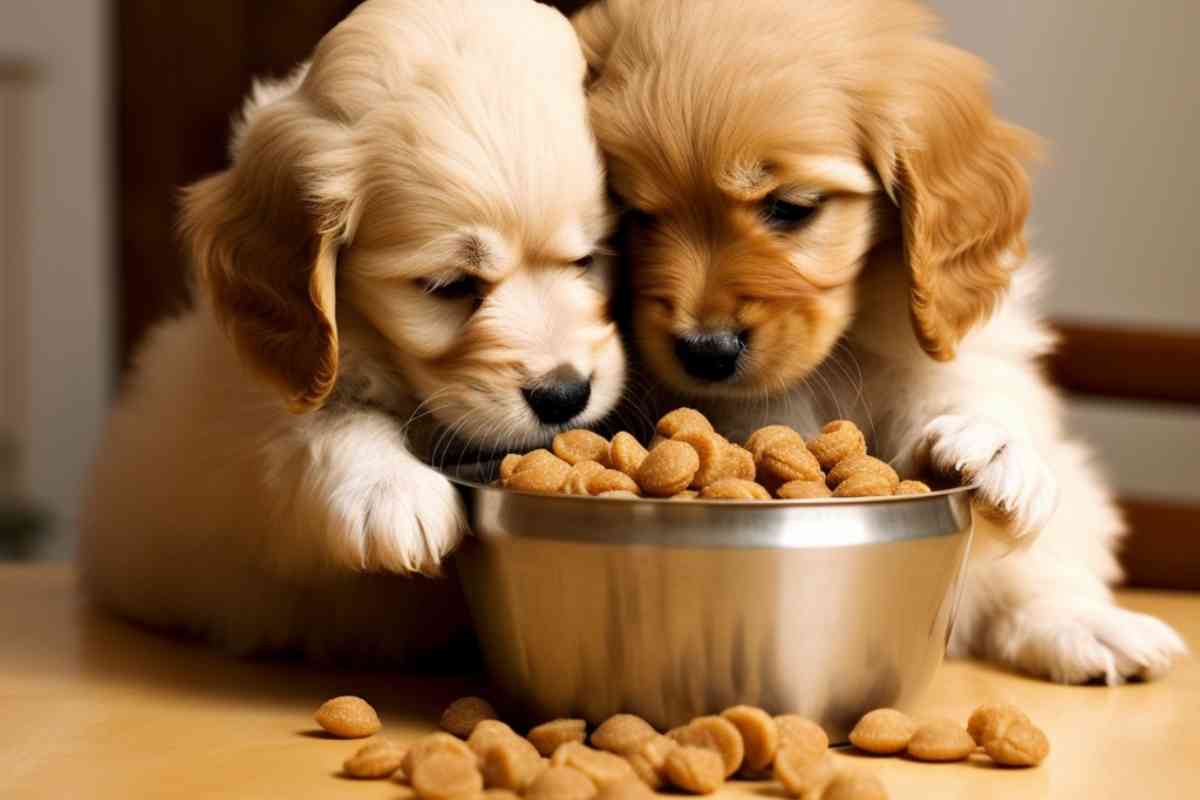
Essential Nutrients for Puppies
Here are some key points about the nutritional requirements for puppies from the VCA Animal Hospitals:
- Protein: Protein requirements for growing puppies are highest immediately after weaning, but the amount of protein they need will steadily decrease thereafter. The recommended protein range for healthy puppy growth is 22-32% on a dry matter basis. These levels support optimal growth, so it is not recommended to exceed these protein levels.
- Fat: Fat is a source of essential fatty acids. It is a concentrated source of energy and it carries fat-soluble vitamins. Excessive energy intake is risky and can lead to obesity and developmental orthopedic disease. For this reason, the fat content for puppies should be rationed between 10-25% on a dry matter basis.
- Calcium: Calcium content in growth formulations for large breed and giant breed puppies have recently become much more stringent so it is important to select a diet that specifies it is designed to meet the nutritional levels established for AAFCO for large breed puppies. Small to medium breeds are less sensitive to the effects of slight over- or under-feeding of calcium, so the levels of calcium can range from 0.7-1.7% on a dry matter basis.
- Digestible carbohydrates: No specific amount of digestible carbohydrates has been identified as optimal for growing puppies, but it is suggested that 20% on a dry matter basis may maximize their health.
Once an appropriate nutritional product has been chosen, no additional vitamin or mineral supplements should be given to support your dog’s exact nutritional needs, and treats should be limited to less than 10% of the total amount of food fed.
Related Posts:
Choosing the Right Puppy Food
Feeding your puppy the right food is crucial for their growth and development. There are several types of puppy food available, each with its own pros and cons. Let’s explore these options and discuss how they can be combined or alternated to meet your puppy’s needs.
Dry Kibble
Dry kibble is a popular choice for many puppy owners due to its convenience and long shelf life. While most puppies were fed on fresh food and table scraps in the past, increasingly dry kibble is the most common dog food.
- Pros: It’s easy to measure, helping control portion sizes. It also helps keep your puppy’s teeth clean by reducing plaque buildup.
- Cons: Some kibbles may contain fillers and artificial ingredients. They also lack the moisture content found in wet foods.
- Feeding Frequency: Typically, puppies should be fed dry kibble three times a day until they’re six months old, after which they can transition to two meals a day.
Wet Food
Wet food, or canned food, is another option that many puppies enjoy.
- Pros: It’s highly palatable and contains more moisture, which can help keep your puppy hydrated.
- Cons: It’s more expensive than kibble and has a shorter shelf life once opened.
- Feeding Frequency: Wet food can be fed in the same frequency as dry kibble. It can also be mixed with kibble for added flavor and moisture.
Fresh Food
Fresh food, like Nom Nom, provides a balanced diet using fresh, whole ingredients.
- Pros: It’s made with high-quality, human-grade ingredients and can be customized to your puppy’s specific needs.
- Cons: It’s more expensive than kibble and canned food, and it requires refrigeration.
- Feeding Frequency: Fresh food can be fed in the same frequency as dry kibble and wet food. It can also be used as a topper to enhance the taste of kibble.
Raw Food
Raw food diets are becoming more popular, but they’re not without controversy. Veterinarians feel compelled to discuss the potential implications for both people and pets of a raw diet.
- Pros: Advocates argue that raw food is more natural and can lead to shinier coats, healthier skin, and higher energy levels. One study found that puppies fed raw tripe, organ meats, and humane leftovers had fewer allergies and atopy.
- Cons: Raw diets can be unbalanced if not properly prepared and carry a risk of bacterial contamination.
- Feeding Frequency: Raw food can be fed in the same frequency as other types of food. However, it’s crucial to consult with a vet before starting a raw diet.
Combining Foods
Combining different types of food can help provide a balanced diet and keep mealtime interesting for your puppy. For example, you might mix kibble with a bit of wet food for added flavor and moisture. Or, you could use fresh food like Nom Nom as a topper to enhance the taste of kibble.
Even adding the right table scraps to your puppy’s diet can be a big boost to their health and happiness. You can also prepare healthy foods like chicken, Brussel sprouts, and cottage cheese for your puppy. Even something unusual like papaya can be a fun and interesting treat for your pup. Just be sure to separate feeding from the table so your pup doesn’t learn to beg.
Remember, any changes to your puppy’s diet should be made gradually to avoid upsetting their stomach. Don’t feed processed, fatty human food like fried foods, pizza, and sweets. And always consult with a vet to determine the best diet for your puppy’s specific needs. Proper nutrition is the foundation of a long, healthy life for your puppy.
Related Posts:
Transitioning to Adult Dog Food
When it comes to transitioning your puppy to adult dog food, there are a few things to keep in mind. Most puppies can start eating adult maintenance food around 12 months of age, but it’s important to consider their breed and size. Small and medium breeds will typically be ready for adult dog food around 12-14 months of age, while large breeds may need to stay on puppy food for a little longer, until they are fully grown.
It’s important to transition your puppy gradually to avoid any stomach upset. You can start by mixing a small amount of adult food into their puppy food and gradually increasing the amount of adult food over the course of 7-10 days. This will allow your puppy’s digestive system to adjust to the new food.
When transitioning to adult dog food, it’s important to choose a high-quality food that meets your dog’s nutritional needs. Look for a food that is specifically formulated for adult dogs, and make sure it contains the appropriate balance of protein, fat, and carbohydrates.
If you’re not sure which adult dog food to choose, talk to your veterinarian. They can help you select a food that is appropriate for your dog’s breed, size, and age.
Here’s a table summarizing when to switch from puppy to adult dog food based on breed size:
| Breed Size | Age to Switch to Adult Food |
|---|---|
| Small (under 20 lbs) | 12-14 months |
| Medium (21-50 lbs) | 12-14 months |
| Large (51-90 lbs) | 14-16 months |
| Giant (over 90 lbs) | 16-18 months |
Remember, every dog is different, so it’s important to work closely with your veterinarian to determine the best time to transition your puppy to adult dog food. By doing so, you can help ensure that your dog stays healthy and happy for years to come.
Frequently Asked Questions
How often should I feed my puppy?
According to the American Kennel Club, puppies need to be fed three to four times a day. [1] This is because they have smaller stomachs and higher metabolic rates than adult dogs. Puppies need more frequent meals to keep their energy levels up and to support their growth and development.
What are the best times of day to feed my puppy?
The best time for your puppy’s first meal is around 7 a.m., noontime for lunch, and 5 p.m. for dinner. [2] The last meal should always be around 5 p.m. so that he will have ample time to digest his food and eliminate one last time before bedtime.
What should I feed my puppy and how much?
The type of food and the amount of food you should feed your puppy depends on their breed, age, and weight. Generally, puppies need a diet that is high in protein and fat to support their growth and development. It is best to consult with your veterinarian to determine the best food and feeding amount for your puppy.
When should I start reducing the number of meals for my puppy?
You can start reducing the number of meals for your puppy when they reach six months of age. At this point, you can start feeding them two meals a day. [1]
Should I feed my puppy in the morning or at night?
It is best to feed your puppy at regular intervals throughout the day. This means feeding them in the morning, at noon, and in the evening. [2] This helps to keep their energy levels up and to support their growth and development.
What is a good feeding schedule for a 4 month old puppy?
A good feeding schedule for a 4-month-old puppy is to feed them four meals a day. [3] Feed them in the morning, at noon, in the late afternoon, and in the evening. This will help to keep their energy levels up and to support their growth and development.
| Time | Amount |
|---|---|
| 7 a.m. | 1/4 cup |
| Noon | 1/4 cup |
| 4 p.m. | 1/4 cup |
| 7 p.m. | 1/4 cup |
This table shows an example feeding schedule for a 4-month-old puppy. However, it is important to consult with your veterinarian to determine the best feeding schedule for your puppy based on their breed, age, and weight.